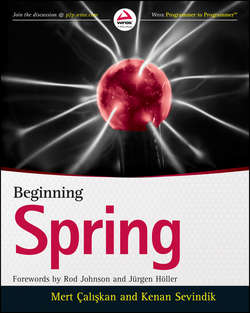Читать книгу Beginning Spring - Höller Jürgen - Страница 2
На сайте Литреса книга снята с продажи.
INTRODUCTION
ОглавлениеTHE SPRING FRAMEWORK IS AN OPEN SOURCE ENTERPRISE APPLICATION framework licensed under Apache License version 2.0, which provides an extensive toolset for building applications that meet the enterprise demands. The idea itself came about because doing development with J2EE (the former version of Java Enterprise Edition) introduced a good deal of complexity in the enterprise world. Creating and deploying beans with Enterprise Java Beans (EJB) was a burden because, to create one bean, you had to create home and component interfaces along with the bean definition. Because the concept of dependency injection was also missing in the EJB world at those times, the lookup approach was the only way to find objects or resources.
The first version of the Spring Framework was based on the code published within Expert One-on-One J2EE Design and Development without EJB (Wrox, 2004) by Rod Johnson and Jürgen Höller. The main idea for the book was to reduce this complexity of enterprise application development with EJBs that was introduced to the EE world with J2EE. The first version of Spring was released in 2002, and milestone releases followed in 2004 and 2005. Version 1.0 brought the lightweight application framework along with features including JDBC abstraction, object relational mapping tools support, transaction management, scheduling and mail abstraction implementations, and the Model View Controller (MVC) web framework.
The 2.0 and 3.0 releases introduced important features to the framework, such as AspectJ support and REST support. At the time of writing this book, version 4.0 was released, and it now complies with the specifications provided by Java Enterprise Edition 7 and with Java 8 Standard Edition, which are the latest versions of Java. Within the book we also try to cover the features of the framework that ships with this latest edition.
Spring gained popularity with its core Dependency Injection (DI) pattern, which is also known as Inversion of Control (IoC). Because object-oriented programming introduces relationships between the objects, the DI approach tries to achieve a loose-coupled design by extracting the management of these dependencies to lead to an easy and manageable implementation. Another spectacular feature of Spring is provided by aspect-oriented programming (AOP), which offers an elegant approach to implementing the cross-cutting concerns in your application. Every web application is in need of features such as exception management, authentication and authorization, logging, and caching. The DI and AOP concepts are covered in detail in Chapters 2 and 8, respectively.
With the help of these major features, Spring provides easily testable, reusable code with no vendor lock-in because it can be ported easily between application servers such as WebLogic, JBoss, and Tomcat. With its layered architecture, it addresses different parts of complex enterprise application development.
We can definitely say that the Spring Framework has become the de facto standard for developing Java enterprise applications. In this book you will find all of the major features brought to the enterprise world by the framework.
